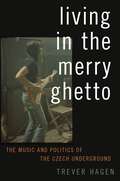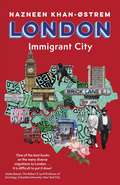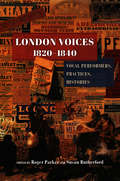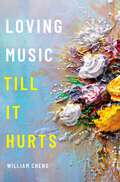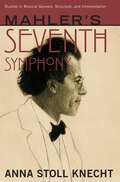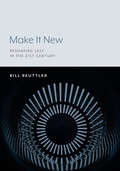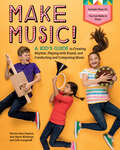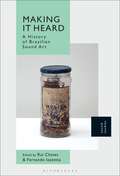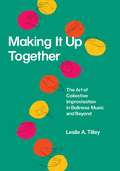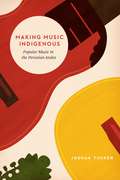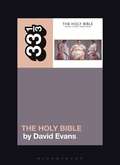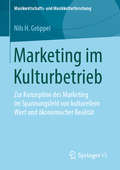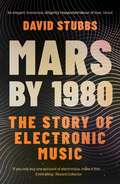- Table View
- List View
LIVING IN THE MERRY GHETTO C: The Music and Politics of the Czech Underground
by Trever HagenLiving in the Merry Ghetto reframes how people use music to build resistance. Author Trever Hagen addresses the social context of illegal music-making in Czechoslovakia during state socialism. He tells the story of a group of rock'n'roll musicians who went underground after 1968, building a parallel world from where they could flourish: the Merry Ghetto. The book examines the case of the Czech Underground and the politics of their music and their way of life, paying close attention to the development of the ensemble The Plastic People of the Universe. Taking in multiple political transitions from the 1940s-2000s, the story focuses on non-official cultural practices such as listening to foreign radio broadcasts, seeking out copied cassette tapes, listening to banned LPs, growing long hair, attending clandestine concerts, smuggling albums via diplomats, recording in home-studios and being thrown in prison for any of these activities. Drawing on ethnographic interviews with Undergrounders, archival research and participant observation, Hagen shows how these practices shaped consciousness, informed bodies and promoted collective action, all of which contributed to an Underground identity.
London: Immigrant City
by Nazneen Khan-ØstremTRANSLATED BY ALISON McCULLOUGH'One of the best books on the many diverse migrations to London . . . revealing the extent to which the diversity of immigrant origins has had transformative effects - through food, music, diverse types of knowledge and so much more. The book is difficult to put it down'Saskia Sassen, The Robert S. Lynd Professor of Sociology, Columbia University, New York'The ultimate book about Great Britain's capital'Dagbladet'One of the best books of the year! . . . This is a book about what a city is and can be'AftenpostenIs there a street in London which does not contain a story from the Empire? Immigrants made London; and they keep remaking it in a thousand different ways. Nazneen Khan-Østrem has drawn a wonderful new map of a city that everyone thought they already knew. She travels around the city, meeting the very people who have created a truly unique metropolis, and shows how London's incredible development is directly attributable to the many different groups of immigrants who arrived after the Second World War, in part due to the Nationality Act of 1948. Her book reveals the historical, cultural and political changes within those communities which have fundamentally transformed the city, and which have rarely been considered alongside each other.Nazneen Khan-Østrem has a cosmopolitan background herself, being a British, Muslim, Asian woman, born in Nairobi and raised in the UK and Norway, which has helped her in unravelling the city's rich immigrant history and its constant ongoing evolution.Drawing on London's rich literature and its musical heritage, she has created an intricate portrait of a strikingly multi-faceted metropolis. Based on extensive research, particularly into aspects not generally covered in the wide array of existing books on the city, London manages to capture the city's enticing complexity and its ruthless vitality.This celebration of London's diverse immigrant communities is timely in the light of the societal fault lines exposed by the Covid-19 pandemic and Brexit. It is a sensitive and insightful book that has a great deal to say to Londoners as well as to Britain as a whole.
London Voices, 1820–1840: Vocal Performers, Practices, Histories
London, 1820. The British capital is a metropolis that overwhelms dwellers and visitors alike with constant exposure to all kinds of sensory stimulation. Over the next two decades, the city’s tumult will reach new heights: as population expansion places different classes in dangerous proximity and ideas of political and social reform linger in the air, London begins to undergo enormous infrastructure change that will alter it forever. It is the London of this period that editors Roger Parker and Susan Rutherford pinpoint in this book, which chooses one broad musical category—voice—and engages with it through essays on music of the streets, theaters, opera houses, and concert halls; on the raising of voices in religious and sociopolitical contexts; and on the perception of voice in literary works and scientific experiments with acoustics. Emphasizing human subjects, this focus on voice allows the authors to explore the multifaceted issues that shaped London, from the anxiety surrounding the city’s importance in the musical world at large to the changing vocal imaginations that permeated the epoch. Capturing the breadth of sonic stimulations and cultures available—and sometimes unavoidable—to residents at the time, London Voices, 1820–1840 sheds new light on music in Britain and the richness of London culture during this period.
London Voices, 1820–1840: Vocal Performers, Practices, Histories
by Roger Parker Susan RutherfordLondon, 1820. The British capital is a metropolis that overwhelms dwellers and visitors alike with constant exposure to all kinds of sensory stimulation. Over the next two decades, the city’s tumult will reach new heights: as population expansion places different classes in dangerous proximity and ideas of political and social reform linger in the air, London begins to undergo enormous infrastructure change that will alter it forever. It is the London of this period that editors Roger Parker and Susan Rutherford pinpoint in this book, which chooses one broad musical category—voice—and engages with it through essays on music of the streets, theaters, opera houses, and concert halls; on the raising of voices in religious and sociopolitical contexts; and on the perception of voice in literary works and scientific experiments with acoustics. Emphasizing human subjects, this focus on voice allows the authors to explore the multifaceted issues that shaped London, from the anxiety surrounding the city’s importance in the musical world at large to the changing vocal imaginations that permeated the epoch. Capturing the breadth of sonic stimulations and cultures available—and sometimes unavoidable—to residents at the time, London Voices, 1820–1840 sheds new light on music in Britain and the richness of London culture during this period.
London Voices, 1820–1840: Vocal Performers, Practices, Histories
by Roger Parker Susan RutherfordLondon, 1820. The British capital is a metropolis that overwhelms dwellers and visitors alike with constant exposure to all kinds of sensory stimulation. Over the next two decades, the city’s tumult will reach new heights: as population expansion places different classes in dangerous proximity and ideas of political and social reform linger in the air, London begins to undergo enormous infrastructure change that will alter it forever. It is the London of this period that editors Roger Parker and Susan Rutherford pinpoint in this book, which chooses one broad musical category—voice—and engages with it through essays on music of the streets, theaters, opera houses, and concert halls; on the raising of voices in religious and sociopolitical contexts; and on the perception of voice in literary works and scientific experiments with acoustics. Emphasizing human subjects, this focus on voice allows the authors to explore the multifaceted issues that shaped London, from the anxiety surrounding the city’s importance in the musical world at large to the changing vocal imaginations that permeated the epoch. Capturing the breadth of sonic stimulations and cultures available—and sometimes unavoidable—to residents at the time, London Voices, 1820–1840 sheds new light on music in Britain and the richness of London culture during this period.
Loving Music Till It Hurts
by William ChengCan music feel pain? Do songs possess dignity? Do symphonies have rights? Of course not, you might say. Yet think of how we anthropomorphize music, not least when we believe it has been somehow mistreated. A singer butchered or mangled the "Star-Spangled Banner" at the Super Bowl. An underrehearsed cover band made a mockery of Led Zeppelin's classics. An orchestra didn't quite do justice to Mozart's Requiem. Such lively language upholds music as a sentient companion susceptible to injury and in need of fierce protection. There's nothing wrong with the human instinct to safeguard beloved music . . . except, perhaps, when this instinct leads us to hurt or neglect fellow human beings in turn: say, by heaping outsized shame upon those who seem to do music wrong; or by rushing to defend a conductor's beautiful recordings while failing to defend the multiple victims who have accused this maestro of sexual assault. Loving Music Till It Hurts is a capacious exploration of how people's head-over-heels attachments to music can variously align or conflict with agendas of social justice. How do we respond when loving music and loving people appear to clash?
MAHLER'S SEVENTH SYMPHONY SMGS C (Studies in Musical Genesis, Structure, and Interpretation)
by Anna Stoll KnechtGustav Mahler's Seventh Symphony stands out as one of the most provocative symphonic statements of the early twentieth century. Throughout its performance history, it has often been heard as "existing in the shadow" of the Sixth Symphony or as "too reminiscent" of Richard Wagner's opera Die Meistersinger von Nürnberg. Anna Stoll Knecht's Mahler's Seventh Symphony offers a new interpretation of the Seventh based on a detailed study of Mahler's compositional materials and a close reading of the finished work. With a focus on sketches previously considered as "discarded," Stoll Knecht exposes unexpected connections between the Seventh and both the Sixth and Meistersinger, confirming that Mahler's compositional project was firmly grounded in a dialogue with works from the past. This referential aspect acts as an important interpretive key to the work, enabling the first thorough analysis of the sketches and drafts for the Seventh, and shedding light on its complex compositional history. Considering each movement of the symphony through a double perspective, genetic and analytic, Stoll Knecht demonstrates how sketch studies and analytical approaches can interact with each other. Mahler's Seventh Symphony exposes new facets of Mahler's musical humor and leads us to rethink much-debated issues concerning the composer's cultural identity, revealing the Seventh's pivotal role within his output.
Make It New: Reshaping Jazz in the 21st Century
by Bill BeuttlerAs jazz enters its second century it is reasserting itself as dynamic and relevant. Boston Globe jazz writer and Emerson College professor Bill Beuttler reveals new ways in which jazz is engaging with society through the vivid biographies and music of Jason Moran, Vijay Iyer, Rudresh Mahanthappa, The Bad Plus, Miguel Zenón, Anat Cohen, Robert Glasper, and Esperanza Spalding. These musicians are freely incorporating other genres of music into jazz—from classical (both western and Indian) to popular (hip-hop, R&B, rock, bluegrass, klezmer, Brazilian choro)—and other art forms as well (literature, film, photography, and other visual arts). This new generation of jazz is increasingly more international and is becoming more open to women as instrumentalists and bandleaders. Contemporary jazz is reasserting itself as a force for social change, prompted by developments such as the Black Lives Matter, #MeToo movements, and the election of Donald Trump.
Make Music!: A Kid's Guide to Creating Rhythm, Playing with Sound, and Conducting and Composing Music
by Norma Jean Haynes Ann Sayre Wiseman John LangstaffThis book puts the &“play&” back in music with inventive ideas for simple homemade instruments and creative instructions for orchestrating sound and rhythm with delightful results — no prior musical experience required!
Making It Heard: A History of Brazilian Sound Art
by Rui Chaves Fernando IazzettaFrom the mid-20th century to present, the Brazilian art, literature, and music scene have been witness to a wealth of creative approaches involving sound. This is the backdrop for Making It Heard: A History of Brazilian Sound Art, a volume that offers an overview of local artists working with performance, experimental vinyl production, sound installation, sculpture, mail art, field recording, and sound mapping. It criticizes universal approaches to art and music historiography that fail to recognize local idiosyncrasies, and creates a local rationale and discourse. Through this approach, Chaves and Iazzetta enable students, researchers, and artists to discover and acknowledge work produced outside of a standard Anglo-European framework.
Making It Up Together: The Art of Collective Improvisation in Balinese Music and Beyond (Chicago Studies in Ethnomusicology)
by Leslie A. TilleyMost studies of musical improvisation focus on individual musicians. But that is not the whole story. From jazz to flamenco, Shona mbira to Javanese gamelan, improvised practices thrive on group creativity, relying on the close interaction of multiple simultaneously improvising performers. In Making It Up Together, Leslie A. Tilley explores the practice of collective musical improvisation cross-culturally, making a case for placing collectivity at the center of improvisation discourse and advocating ethnographically informed music analysis as a powerful tool for investigating improvisational processes. Through two contrasting Balinese case studies—of the reyong gong chime’s melodic norot practice and the interlocking drumming tradition kendang arja—Tilley proposes and tests analytical frameworks for examining collectively improvised performance. At the micro-level, Tilley’s analyses offer insight into the note-by-note decisions of improvising performers; at the macro-level, they illuminate larger musical, discursive, structural, and cultural factors shaping those decisions. This multi-tiered inquiry reveals that unpacking how performers play and imagine as a collective is crucial to understanding improvisation and demonstrates how music analysis can elucidate these complex musical and interactional relationships. Highlighting connections with diverse genres from various music cultures, Tilley’s examinations of collective improvisation also suggest rich potential for cross-genre exploration. The surrounding discussions point to larger theories of communication and interaction, creativity and cognition that will be of interest to a range of readers—from ethnomusicologists and music theorists to cognitive psychologists, jazz studies scholars, and improvising performers. Setting new parameters for the study of improvisation, Making It Up Together opens up fresh possibilities for understanding the creative process, in music and beyond.
Making It Up Together: The Art of Collective Improvisation in Balinese Music and Beyond (Chicago Studies in Ethnomusicology)
by Leslie A. TilleyMost studies of musical improvisation focus on individual musicians. But that is not the whole story. From jazz to flamenco, Shona mbira to Javanese gamelan, improvised practices thrive on group creativity, relying on the close interaction of multiple simultaneously improvising performers. In Making It Up Together, Leslie A. Tilley explores the practice of collective musical improvisation cross-culturally, making a case for placing collectivity at the center of improvisation discourse and advocating ethnographically informed music analysis as a powerful tool for investigating improvisational processes. Through two contrasting Balinese case studies—of the reyong gong chime’s melodic norot practice and the interlocking drumming tradition kendang arja—Tilley proposes and tests analytical frameworks for examining collectively improvised performance. At the micro-level, Tilley’s analyses offer insight into the note-by-note decisions of improvising performers; at the macro-level, they illuminate larger musical, discursive, structural, and cultural factors shaping those decisions. This multi-tiered inquiry reveals that unpacking how performers play and imagine as a collective is crucial to understanding improvisation and demonstrates how music analysis can elucidate these complex musical and interactional relationships. Highlighting connections with diverse genres from various music cultures, Tilley’s examinations of collective improvisation also suggest rich potential for cross-genre exploration. The surrounding discussions point to larger theories of communication and interaction, creativity and cognition that will be of interest to a range of readers—from ethnomusicologists and music theorists to cognitive psychologists, jazz studies scholars, and improvising performers. Setting new parameters for the study of improvisation, Making It Up Together opens up fresh possibilities for understanding the creative process, in music and beyond.
Making It Up Together: The Art of Collective Improvisation in Balinese Music and Beyond (Chicago Studies in Ethnomusicology)
by Leslie A. TilleyMost studies of musical improvisation focus on individual musicians. But that is not the whole story. From jazz to flamenco, Shona mbira to Javanese gamelan, improvised practices thrive on group creativity, relying on the close interaction of multiple simultaneously improvising performers. In Making It Up Together, Leslie A. Tilley explores the practice of collective musical improvisation cross-culturally, making a case for placing collectivity at the center of improvisation discourse and advocating ethnographically informed music analysis as a powerful tool for investigating improvisational processes. Through two contrasting Balinese case studies—of the reyong gong chime’s melodic norot practice and the interlocking drumming tradition kendang arja—Tilley proposes and tests analytical frameworks for examining collectively improvised performance. At the micro-level, Tilley’s analyses offer insight into the note-by-note decisions of improvising performers; at the macro-level, they illuminate larger musical, discursive, structural, and cultural factors shaping those decisions. This multi-tiered inquiry reveals that unpacking how performers play and imagine as a collective is crucial to understanding improvisation and demonstrates how music analysis can elucidate these complex musical and interactional relationships. Highlighting connections with diverse genres from various music cultures, Tilley’s examinations of collective improvisation also suggest rich potential for cross-genre exploration. The surrounding discussions point to larger theories of communication and interaction, creativity and cognition that will be of interest to a range of readers—from ethnomusicologists and music theorists to cognitive psychologists, jazz studies scholars, and improvising performers. Setting new parameters for the study of improvisation, Making It Up Together opens up fresh possibilities for understanding the creative process, in music and beyond.
Making It Up Together: The Art of Collective Improvisation in Balinese Music and Beyond (Chicago Studies in Ethnomusicology)
by Leslie A. TilleyMost studies of musical improvisation focus on individual musicians. But that is not the whole story. From jazz to flamenco, Shona mbira to Javanese gamelan, improvised practices thrive on group creativity, relying on the close interaction of multiple simultaneously improvising performers. In Making It Up Together, Leslie A. Tilley explores the practice of collective musical improvisation cross-culturally, making a case for placing collectivity at the center of improvisation discourse and advocating ethnographically informed music analysis as a powerful tool for investigating improvisational processes. Through two contrasting Balinese case studies—of the reyong gong chime’s melodic norot practice and the interlocking drumming tradition kendang arja—Tilley proposes and tests analytical frameworks for examining collectively improvised performance. At the micro-level, Tilley’s analyses offer insight into the note-by-note decisions of improvising performers; at the macro-level, they illuminate larger musical, discursive, structural, and cultural factors shaping those decisions. This multi-tiered inquiry reveals that unpacking how performers play and imagine as a collective is crucial to understanding improvisation and demonstrates how music analysis can elucidate these complex musical and interactional relationships. Highlighting connections with diverse genres from various music cultures, Tilley’s examinations of collective improvisation also suggest rich potential for cross-genre exploration. The surrounding discussions point to larger theories of communication and interaction, creativity and cognition that will be of interest to a range of readers—from ethnomusicologists and music theorists to cognitive psychologists, jazz studies scholars, and improvising performers. Setting new parameters for the study of improvisation, Making It Up Together opens up fresh possibilities for understanding the creative process, in music and beyond.
Making It Up Together: The Art of Collective Improvisation in Balinese Music and Beyond (Chicago Studies in Ethnomusicology)
by Leslie A. TilleyMost studies of musical improvisation focus on individual musicians. But that is not the whole story. From jazz to flamenco, Shona mbira to Javanese gamelan, improvised practices thrive on group creativity, relying on the close interaction of multiple simultaneously improvising performers. In Making It Up Together, Leslie A. Tilley explores the practice of collective musical improvisation cross-culturally, making a case for placing collectivity at the center of improvisation discourse and advocating ethnographically informed music analysis as a powerful tool for investigating improvisational processes. Through two contrasting Balinese case studies—of the reyong gong chime’s melodic norot practice and the interlocking drumming tradition kendang arja—Tilley proposes and tests analytical frameworks for examining collectively improvised performance. At the micro-level, Tilley’s analyses offer insight into the note-by-note decisions of improvising performers; at the macro-level, they illuminate larger musical, discursive, structural, and cultural factors shaping those decisions. This multi-tiered inquiry reveals that unpacking how performers play and imagine as a collective is crucial to understanding improvisation and demonstrates how music analysis can elucidate these complex musical and interactional relationships. Highlighting connections with diverse genres from various music cultures, Tilley’s examinations of collective improvisation also suggest rich potential for cross-genre exploration. The surrounding discussions point to larger theories of communication and interaction, creativity and cognition that will be of interest to a range of readers—from ethnomusicologists and music theorists to cognitive psychologists, jazz studies scholars, and improvising performers. Setting new parameters for the study of improvisation, Making It Up Together opens up fresh possibilities for understanding the creative process, in music and beyond.
Making It Up Together: The Art of Collective Improvisation in Balinese Music and Beyond (Chicago Studies in Ethnomusicology)
by Leslie A. TilleyMost studies of musical improvisation focus on individual musicians. But that is not the whole story. From jazz to flamenco, Shona mbira to Javanese gamelan, improvised practices thrive on group creativity, relying on the close interaction of multiple simultaneously improvising performers. In Making It Up Together, Leslie A. Tilley explores the practice of collective musical improvisation cross-culturally, making a case for placing collectivity at the center of improvisation discourse and advocating ethnographically informed music analysis as a powerful tool for investigating improvisational processes. Through two contrasting Balinese case studies—of the reyong gong chime’s melodic norot practice and the interlocking drumming tradition kendang arja—Tilley proposes and tests analytical frameworks for examining collectively improvised performance. At the micro-level, Tilley’s analyses offer insight into the note-by-note decisions of improvising performers; at the macro-level, they illuminate larger musical, discursive, structural, and cultural factors shaping those decisions. This multi-tiered inquiry reveals that unpacking how performers play and imagine as a collective is crucial to understanding improvisation and demonstrates how music analysis can elucidate these complex musical and interactional relationships. Highlighting connections with diverse genres from various music cultures, Tilley’s examinations of collective improvisation also suggest rich potential for cross-genre exploration. The surrounding discussions point to larger theories of communication and interaction, creativity and cognition that will be of interest to a range of readers—from ethnomusicologists and music theorists to cognitive psychologists, jazz studies scholars, and improvising performers. Setting new parameters for the study of improvisation, Making It Up Together opens up fresh possibilities for understanding the creative process, in music and beyond.
Making Music Indigenous: Popular Music in the Peruvian Andes (Chicago Studies in Ethnomusicology)
by Joshua TuckerWhen thinking of indigenous music, many people may imagine acoustic instruments and pastoral settings far removed from the whirl of modern life. But, in contemporary Peru, indigenous chimaycha music has become a wildly popular genre that is even heard in the nightclubs of Lima. In Making Music Indigenous, Joshua Tucker traces the history of this music and its key performers over fifty years to show that there is no single way to “sound indigenous.” The musicians Tucker follows make indigenous culture and identity visible in contemporary society by establishing a cultural and political presence for Peru’s indigenous peoples through activism, artisanship, and performance. This musical representation of indigeneity not only helps shape contemporary culture, it also provides a lens through which to reflect on the country’s past. Tucker argues that by following the musicians that have championed chimaycha music in its many forms, we can trace shifting meanings of indigeneity—and indeed, uncover the ways it is constructed, transformed, and ultimately recreated through music.
Making Music Indigenous: Popular Music in the Peruvian Andes (Chicago Studies in Ethnomusicology)
by Joshua TuckerWhen thinking of indigenous music, many people may imagine acoustic instruments and pastoral settings far removed from the whirl of modern life. But, in contemporary Peru, indigenous chimaycha music has become a wildly popular genre that is even heard in the nightclubs of Lima. In Making Music Indigenous, Joshua Tucker traces the history of this music and its key performers over fifty years to show that there is no single way to “sound indigenous.” The musicians Tucker follows make indigenous culture and identity visible in contemporary society by establishing a cultural and political presence for Peru’s indigenous peoples through activism, artisanship, and performance. This musical representation of indigeneity not only helps shape contemporary culture, it also provides a lens through which to reflect on the country’s past. Tucker argues that by following the musicians that have championed chimaycha music in its many forms, we can trace shifting meanings of indigeneity—and indeed, uncover the ways it is constructed, transformed, and ultimately recreated through music.
Making Music Indigenous: Popular Music in the Peruvian Andes (Chicago Studies in Ethnomusicology)
by Joshua TuckerWhen thinking of indigenous music, many people may imagine acoustic instruments and pastoral settings far removed from the whirl of modern life. But, in contemporary Peru, indigenous chimaycha music has become a wildly popular genre that is even heard in the nightclubs of Lima. In Making Music Indigenous, Joshua Tucker traces the history of this music and its key performers over fifty years to show that there is no single way to “sound indigenous.” The musicians Tucker follows make indigenous culture and identity visible in contemporary society by establishing a cultural and political presence for Peru’s indigenous peoples through activism, artisanship, and performance. This musical representation of indigeneity not only helps shape contemporary culture, it also provides a lens through which to reflect on the country’s past. Tucker argues that by following the musicians that have championed chimaycha music in its many forms, we can trace shifting meanings of indigeneity—and indeed, uncover the ways it is constructed, transformed, and ultimately recreated through music.
Making Music Indigenous: Popular Music in the Peruvian Andes (Chicago Studies in Ethnomusicology)
by Joshua TuckerWhen thinking of indigenous music, many people may imagine acoustic instruments and pastoral settings far removed from the whirl of modern life. But, in contemporary Peru, indigenous chimaycha music has become a wildly popular genre that is even heard in the nightclubs of Lima. In Making Music Indigenous, Joshua Tucker traces the history of this music and its key performers over fifty years to show that there is no single way to “sound indigenous.” The musicians Tucker follows make indigenous culture and identity visible in contemporary society by establishing a cultural and political presence for Peru’s indigenous peoples through activism, artisanship, and performance. This musical representation of indigeneity not only helps shape contemporary culture, it also provides a lens through which to reflect on the country’s past. Tucker argues that by following the musicians that have championed chimaycha music in its many forms, we can trace shifting meanings of indigeneity—and indeed, uncover the ways it is constructed, transformed, and ultimately recreated through music.
Making Music Indigenous: Popular Music in the Peruvian Andes (Chicago Studies in Ethnomusicology)
by Joshua TuckerWhen thinking of indigenous music, many people may imagine acoustic instruments and pastoral settings far removed from the whirl of modern life. But, in contemporary Peru, indigenous chimaycha music has become a wildly popular genre that is even heard in the nightclubs of Lima. In Making Music Indigenous, Joshua Tucker traces the history of this music and its key performers over fifty years to show that there is no single way to “sound indigenous.” The musicians Tucker follows make indigenous culture and identity visible in contemporary society by establishing a cultural and political presence for Peru’s indigenous peoples through activism, artisanship, and performance. This musical representation of indigeneity not only helps shape contemporary culture, it also provides a lens through which to reflect on the country’s past. Tucker argues that by following the musicians that have championed chimaycha music in its many forms, we can trace shifting meanings of indigeneity—and indeed, uncover the ways it is constructed, transformed, and ultimately recreated through music.
Making Music Indigenous: Popular Music in the Peruvian Andes (Chicago Studies in Ethnomusicology)
by Joshua TuckerWhen thinking of indigenous music, many people may imagine acoustic instruments and pastoral settings far removed from the whirl of modern life. But, in contemporary Peru, indigenous chimaycha music has become a wildly popular genre that is even heard in the nightclubs of Lima. In Making Music Indigenous, Joshua Tucker traces the history of this music and its key performers over fifty years to show that there is no single way to “sound indigenous.” The musicians Tucker follows make indigenous culture and identity visible in contemporary society by establishing a cultural and political presence for Peru’s indigenous peoples through activism, artisanship, and performance. This musical representation of indigeneity not only helps shape contemporary culture, it also provides a lens through which to reflect on the country’s past. Tucker argues that by following the musicians that have championed chimaycha music in its many forms, we can trace shifting meanings of indigeneity—and indeed, uncover the ways it is constructed, transformed, and ultimately recreated through music.
Manic Street Preachers’ The Holy Bible (33 1/3 #137)
by David EvansIn August 1994, Manic Street Preachers released The Holy Bible, a dark, fiercely intelligent album that explored such themes as mental illness, murder and war. Richey Edwards, the band's lyricist and motive force, vanished five months later; he was never found. In his absence The Holy Bible entered the rock canon alongside Joy Division's Closer and Nirvana's In Utero, the valedictory works of troubled young men. This book tells the dramatic story of Manic Street Preachers' masterpiece. Tracing the album's origins in the Valleys, an industrialised region of South Wales where the band spent their formative years, the author argues that The Holy Bible can be seen as a meditation on the uses and abuses of history.
Marketing im Kulturbetrieb: Zur Konzeption des Marketing im Spannungsfeld von kulturellem Wert und ökonomischer Realität (Musikwirtschafts- und Musikkulturforschung)
by Nils H. GröppelIn diesem Buch wird die Konzeption eines kulturbetriebsspezifischen Marketing vorgestellt. Sie verdichtet und systematisiert Aussagen über die Austauschprozesse im Kulturbetrieb und bietet damit interessierten Praktikern, Dozenten und Studierenden gleichermaßen Hilfestellungen. Dem Forschungsansatz der Kulturbetriebslehre folgend gilt es bei der Abhandlung die Wechselwirkung von symbolischer und ökonomischer Funktion von Kulturgütern zu berücksichtigen. So werden in einer sektoralen Annäherung, um der Simultanität und Interaktion der Funktionen Rechnung zu tragen, Gestalten und Merkmale der Kultur erörtert, die der Aufarbeitung der entsprechenden Austauschprozesse als Ansatzpunkte dienen. Darüber hinaus entwirft eine branchenspezifische Annäherung die Besonderheiten des „Marketing im Kulturbetrieb“ anhand einer Fallstudie zur Musikwirtschaft, die als institutioneller Rahmen der Vermarktung von kulturellen Symbolen (Musik bzw. Musikaufnahmen) genutzt wird.
Mars by 1980: The Story of Electronic Music
by David StubbsElectronic music is now ubiquitous, from mainstream pop hits to the furthest reaches of the avant garde. But how did we get here? In Mars by 1980, David Stubbs charts the evolution of synthesised tones, from the earliest mechanical experiments in the late nineteenth century, through the musique concrete of the Futurists and radical composers such as Pierre Schaeffer and Karl Stockhausen, to the gradual absorption of electronic instrumentation into the mainstream, be it through the BBC Radiophonic Workshop, grandiose prog rock or the DIY approach of electronica, house and techno.Stubbs tells a tale of mavericks and future dreamers, malfunctioning devices and sonic mayhem. But above all, he describes an essential story of authenticity: is this music? Mars by 1980 is the definitive account that answers this question.
